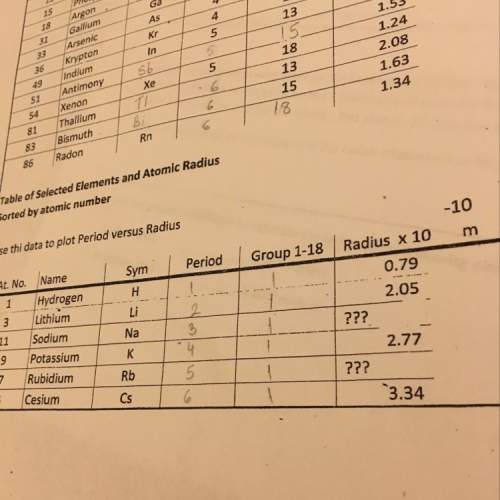
A reaction A ( aq ) + B ( aq ) − ⇀ ↽ − C ( aq ) has a standard free‑energy change of − 5.24 kJ / mol at 25 °C. What are the concentrations of A , B , and C at equilibrium if, at the beginning of the reaction, their concentrations are 0.30 M, 0.40 M, and 0 M, respectively?

Answers: 1
Another question on Chemistry

Chemistry, 22.06.2019 08:00
An electron moved from shell n = 2 to shell n = 1. what most likely happened during the transition? a fraction of a photon was added. a photon of energy was absorbed. a fraction of a photon was removed. a photon of energy was released.
Answers: 1

Chemistry, 22.06.2019 12:00
Why are people not able to skip a dive to the deepest part of the ocean
Answers: 1

Chemistry, 22.06.2019 22:30
You just calculated that the heat of fusion for chloromethane is 6400 j/mol. the heat of fusion for hydrogen is 120 j/mol.? which of the following account for this difference? more than one correcta. chloromethane can absorb more energy at the same temperature. b. hydrogen has stronger intermolecular forces than chloromethane. c. hydrogen molecules can pack more closely than chloromethane molecules. d. chloromethane experiences dipole-dipole interactions. e. chloromethane has a higher molar mass than hydrogen.
Answers: 3

Chemistry, 23.06.2019 11:50
What is the oxidation half-reaction for this unbalanced redox equation? cr2o72– + fe2+ → cr3+ + fe3+ cr3+ → cr2o72– cr2o72– → cr3+ fe3+ → fe2+ fe2+ → fe3+?
Answers: 2
You know the right answer?
A reaction A ( aq ) + B ( aq ) − ⇀ ↽ − C ( aq ) has a standard free‑energy change of − 5.24 kJ / mol...
Questions




History, 21.05.2020 23:02


Mathematics, 21.05.2020 23:02






Mathematics, 21.05.2020 23:02

Social Studies, 21.05.2020 23:02

Mathematics, 21.05.2020 23:02



Mathematics, 21.05.2020 23:02

Mathematics, 21.05.2020 23:02

Mathematics, 21.05.2020 23:02

![[A]_{eq}=0.11M](/tpl/images/0559/0215/f777c.png)
![[B]_{eq}=0.21M](/tpl/images/0559/0215/4b396.png)
![[C]_{eq}=0.19M](/tpl/images/0559/0215/f0920.png)
![Kc=exp(-\frac{\Delta _RG }{RT} )=exp[-\frac{-5240J/mol }{(8.314J/mol*K)(298.15K)} ]=8.28](/tpl/images/0559/0215/70087.png)
 due to the chemical reaction, we obtain:
due to the chemical reaction, we obtain:

![[A]_{eq}=0.3M-0.19M=0.11M](/tpl/images/0559/0215/f33fb.png)
![[B]_{eq}=0.4M-0.19M=0.21M](/tpl/images/0559/0215/a81c9.png)



